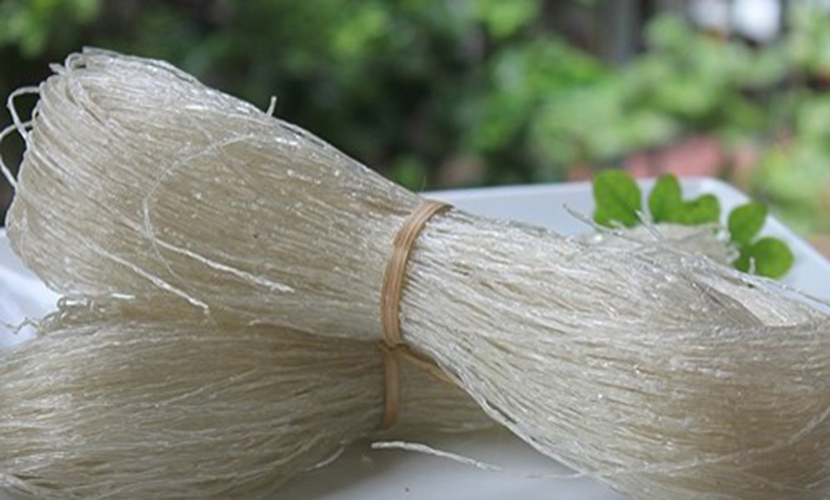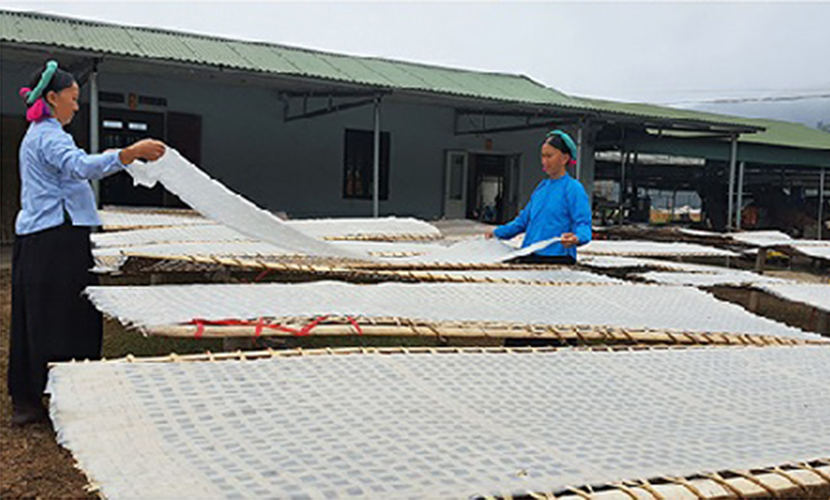
La A Nong, was a farmer from San Chi ethnic group, Huc Dong commune, Binh Lieu district, Quang Ninh province. He has involved in vermicelli-making since his childhood. However, he never imagined that one day he would become the head of a production cooperative of Vietnamese canna vermicelli.
La A Nong shared that Huc Dong Commune, his hometown, has a long-standing tradition of vermicelli-making. In the past, his entire family participated in making Vietnamese canna vermicelli. However, the work was carried out manually and in small quantities. As a result, his family sold vermicelli only within the local commune, and production was often inconsistent.

Vietnamese canna vermicelli
In 2013, La A Nong graduated from the Primary Education Department at Hai Phong University of Education. Instead of pursuing a teaching career, he chose to make Vietnamese canna vermicelli. When asked why he took such an unexpected turn, he explained his reasoning. During his student years, he often wen to vermicelli-producing villages near Hanoi to observe the production process.
“I wanted to understand how they could produce such large quantities of canna starch noodles. Also, I would like to how the trade helped so many people become prosperous,” he said. After graduating, La A Nong often sat at home, gazing at the lush canna fields around the village. Seeing that potential, he decided to borrow money to invest in a vermicelli production facility.
Raising over one billion VND to buy a flour grinder, sheet-making machine, and cutting machine required tremendous effort. In addition, he carefully persuaded relatives to see the feasibility of his plan and help him secure loans.
“I am of the San Chi ethnic group, and my relatives are too, living in a particularly disadvantaged commune. Under the government policy, each household could borrow 50 million VND for poor and ethnic minority households. When I explained my plan, everyone stepped in to help,” he said.

Binh Lieu canna vermicelli
In 2014, La A Nong established the Dinh Trung Cooperative, with an initial seven members. In the 2014 vermicelli season, the cooperative earned nearly 500 million VND in profit.
Seeing the results, La A Nong and the members confidently invested further in machinery and workshops. In the 2015 and 2016 seasons, its canna vermicelli sold out, generating over 600 million VND in annual profits.
The cooperative ensures that it would share profits equally among all contributing households. It also creates jobs for 25 workers during the vermicelli production season, offering monthly salaries around four million VND.
Showing the carefully packaged dong vermicelli with clear origin labels, La A Nong shared his story. He said that after setting up the cooperative and joining the “One commune, One product” (OCOP) program, they received help with labeling.

Vietnamese canna vermicelli facility
They were also given funding to showcase their products at fairs and exhibitions. “Whenever there is a sales program, wherever it is, I go. I want as many people as possible to know about our Vietnamese canna vermicelli,” he said with a confident smile.
According to La A Nong, the vermicelli produced by the cooperative is made entirely from canna roots, without any preservatives. When cooked, it is chewy, delicious, and does not fall apart, so anyone who has tried it enjoys it very much.
The cooperative’s Vietnamese canna vermicelli sells for between 80,000 and 100,000 VND per kilogram. Thanks to growing demand, sales rose from 25 tons in 2015 to more than 30 tons in 2016 and about 45 tons in 2017.
La A Nong is planning to sign contracts to purchase dong rhizomes from local farmers at the start of each season. “Convincing the villagers is not simple, but it is necessary to ensure raw materials for production. At the same time, farmers can invest in production with peace of mind, without worrying about unstable prices for their products,” he said.
Vietnamese source: https://baodantoc.vn/lam-giau-tu-nghe-truyen-thong-8808.htm
